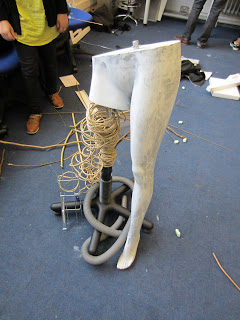The Willard Asylum of New York was an asylum for the chronically insane. Many of Willard's patients, once having entered it's wall, left only to be placed in it's graveyard filled with masses of, not named, but numbered graves. From within the old, abandoned building were discovered hundreds of suitcases of it's previous patients. Walter Benjamin describes possession as 'the most intimate relationship that one can have to objects' and that ultimately, 'it is he who lives in them'. The lost suitcases of Willard invoke this very sensation: the owners seem to be very much alive in
their possessions.
This now battered and deteriorating suitcase once belonged to a Delmar H. It was originally from a hotel in Bolgna,Italy.


Each suitcase contained fascinating objects, from everyday necessities to trinkets and ornaments and the owners most prized possessions. One patient, identified only as 'Anna', contained a list of all her glamorous objects...
It is most interesting to see the objects that they chose to bring with them, considering that they knew that the chances of them returning to their normal lives were slim. It makes one wonder what these possessions meant to their owners, what stories lie behind their decision to take them to their death bed, what deep connection they had to these inanimate objects and how they defined their personalities or even their illnesses..
 |
| Eleanor's sewing supplies. |
 |
| This suitcase belonged to 'Dymtre'. It was said to have had 'notebooks filled with drawings of sine waves and mathematical things like that. There’s a wedding picture of Dmytre and his wife, and she’s holding a bouquet of fake flowers, which were also in the case.'Dmytre was said to have had gotten arrested by the Secret Service because he went to Washington, D.C. for saying that he was Margaret Truman’s husband. |
 |
Details of objects found in Dymtre's suitcase, including a red cross pin and a postcard.
|
Looking at these photographs, I am not filled with a sense of morbidity but rather an odd kind of nostalgia for a life I never lived. These objects are brimming with tales of their owners lives, each object unique. There is a strange comfort in looking at them, not simply because of their rarity or historical significance, but because they were part of someone's routine and by extension, them, therefore coming to life before us, revealing the lives of these long forgotten patients in profound and unexpected ways.
As Mrs Ramsay says in Virginia Woolf's 'To The Lighthouse': 'It was odd, she thought, how when one was alone, one leant to things, inanimate things; trees, streams, flowers; felt they expressed one; felt they become one; felt they knew one, felt they were one; felt an irrational tenderness thus...as for oneself.'

















































